Most people recognise the mackerel from the fishmonger's slab. A sleek, slender bodied fish with an average weight between 6 and 10ozs, but growing to over 6lbs. The back is coloured iridescent blue/green with black irregular lines across it fading into a paler green in the middle, then to a pale white belly flecked with faint pink and bronze shading.
SEASON
In the south west of England and Wales the first fish show as singles during late April. Mackerel start to shoal together during late May to mid June and move close inshore from June to September before the first of the autumnal gales start to break up the shoals and disperse the fish. Odd fish will still be taken from the shore right through until late November in milder years.
In west Scotland the fish show during May staying until November again, but in the North Sea the mackerel are scarcer and rarely show before July and are gone by early September.
WHERE TO FIND MACKEREL SHORE
Mackerel like tide races, so fish venues like the ends of headlands, breakwaters, jetties, rock edges and piers where the passing tide will hold fish.
Deep water, shingle backed beaches like Chesil Beach in Dorset will hold fish close in from May onwards. Shallower beaches, even clean sand surf beaches will also pull mackerel inshore during the height of summer over high tide in calm conditions.
BOAT
Mackerel in the early season are very scattered, but often appear more numerous around the edges of deep water reefs, or over broken ground.
By mid summer they have shoaled and can be present just about anywhere, but concentrate again around any reefs, over broken ground or flat boulder areas, but again try drifting through tide races off the ends of headlands and the like. Another good place is off estuary mouths on the ebbing tide when the force of the out coming water will pull the mackerel in to feed along the distinctive edge of fresh and saltwater.
Offshore sewer outflows can also be a holding ground for mackerel throughout the season.
WATCH FOR SIGNS
There are signs to look for that help you locate where the mackerel shoals are.
Birds diving into the sea, either close in off the beach or offshore nearly always indicate the presence of mackerel close to the surface.
In the boat, watch for packs of jellyfish suddenly appearing. The jellyfish indicate a slightly warmer water band that will also attract and hold the mackerel.
When mackerel feed they create small air bubbles that break across the surface like that in mineral water. This was how the old commercial fisherman before the time of sounders and engines found the fish. This is easy to see, but few angler know to look.
Spend time feathering near current lines that carry twigs, seaweed and other floating debris. Mackerel like to work these current edges.
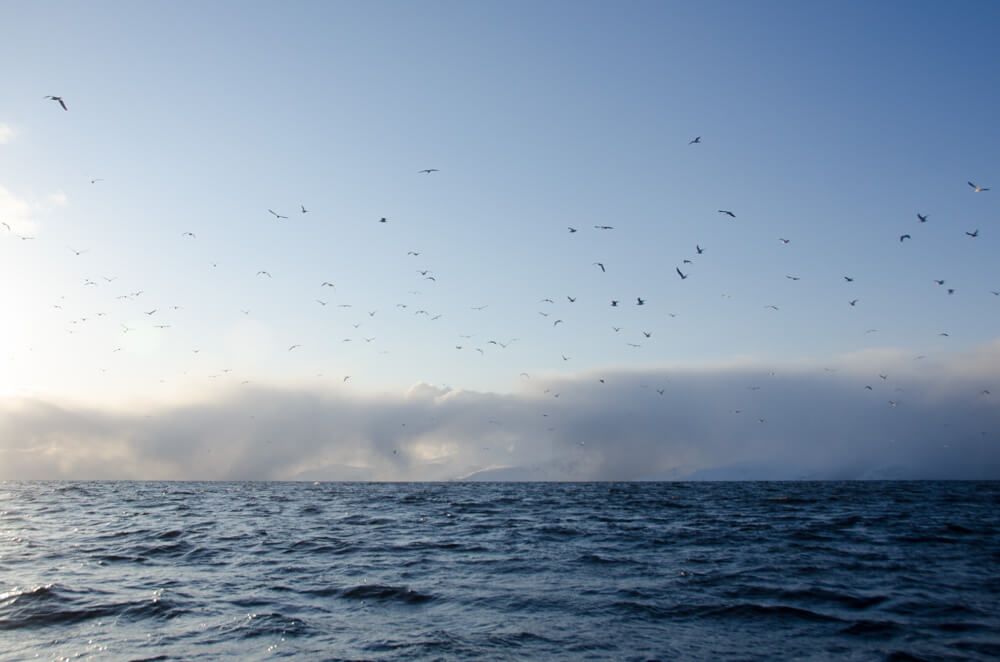
TIDES SHORE
From deep water beaches, headlands, breakwaters etc, then neap tides will produce fish, but never in the same quantity as on the bigger spring tides.
From the shallower beaches, then mackerel only move inshore with the very biggest spring tides of the cycle. Fish will rarely, if ever, be present on neap tides.
BOAT
It makes little difference to overall catches, but the mackerel may be more spread out on the spring tides than they are on the neaps, and also much closer to shore.
WEATHER SHORE
The very best conditions are the sultry, thunderous evenings without a breath of wind when the air is oppressive. This sequence sees the mackerel move inshore with the new tide and push baitfish shoals tight in onto the beach line. It also proves good when fishing rock marks.
Once sea conditions start to get choppy, the water starts to colour, and the winds rise the inshore mackerel fishing deteriorates rapidly.
BOAT
During really calm seas the mackerel work very close to the surface. They fall towards the seabed quickly as dusk arrives and cease to feed. Dawn sees them at seabed level, rising higher in the water as the day progresses.
The shoals also stay near the seabed during rough conditions and will leave the shallower areas seeking out more tolerant water with a greater depth.
FISHING METHODS
SHORE
For bait purposes only, feathering is the quickest way to get a box full of baits.
The best feathers are actually lures and not the old mackerel feathers made from cock and hen hackles. Go for Mustad Hokkai's, Shakespeare Flat Jack lures, any feathers with a bright tinsel body such as the Silver Shrimp and also red ribbon lures. Anything with fluorescent colours also catches better than plain feathers.
These are just cast out as far as possible and retrieved erratically until you feel mackerel hook themselves.
More sporting, and often catching enough bait for a single session just as quickly is spinning. Choose any spinner upto about an ounce in silver chrome or gold. A steady retrieve with the spinner works best.
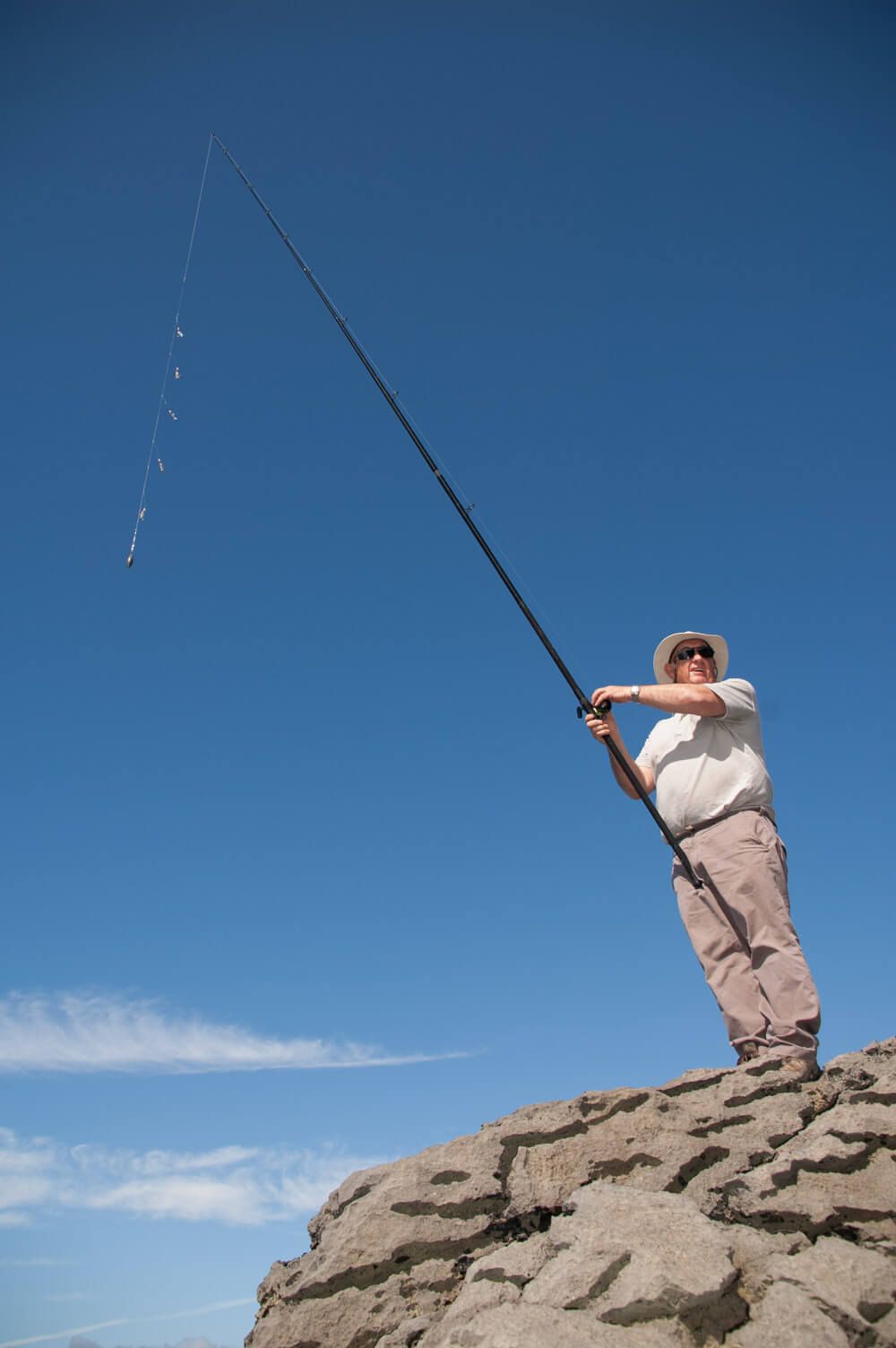
BOAT
The same type of feather/lures used for shore fishing catch just as well offshore.
Instead of using a lead weight as a sinker, use a chromed pirk made from 10mm gas tubing or even a pirk made from 4ins of 1in diameter tubing weighing upto 8ozs. The pirk needs no hook for it's not there to actually catch the fish but the reflections off the pirk help attract the mackerel to the feathers.
Working the feathers is a simple persistent lifting and lowering of the rod tip which imparts some life to the lures and makes them appear like a small group of baitfish.
Don't just let the feathers down to the seabed and then work the rod tip up and down without thinking. The key to consistent mackerel catches, especially early in the season, is to keep trying different depths until the fish are found. Generally speaking, they are close to the seabed early and late in the year, and when seas are calming down after summer storms. In mid summer they can be from seabed to just sub surface, the latter especially during prolonged calm spells.
Another good dodge is to mount a Booby Rattle Bead below the feathers. As the feathers are worked, this obviously rattles and again draws fish in to the lures.
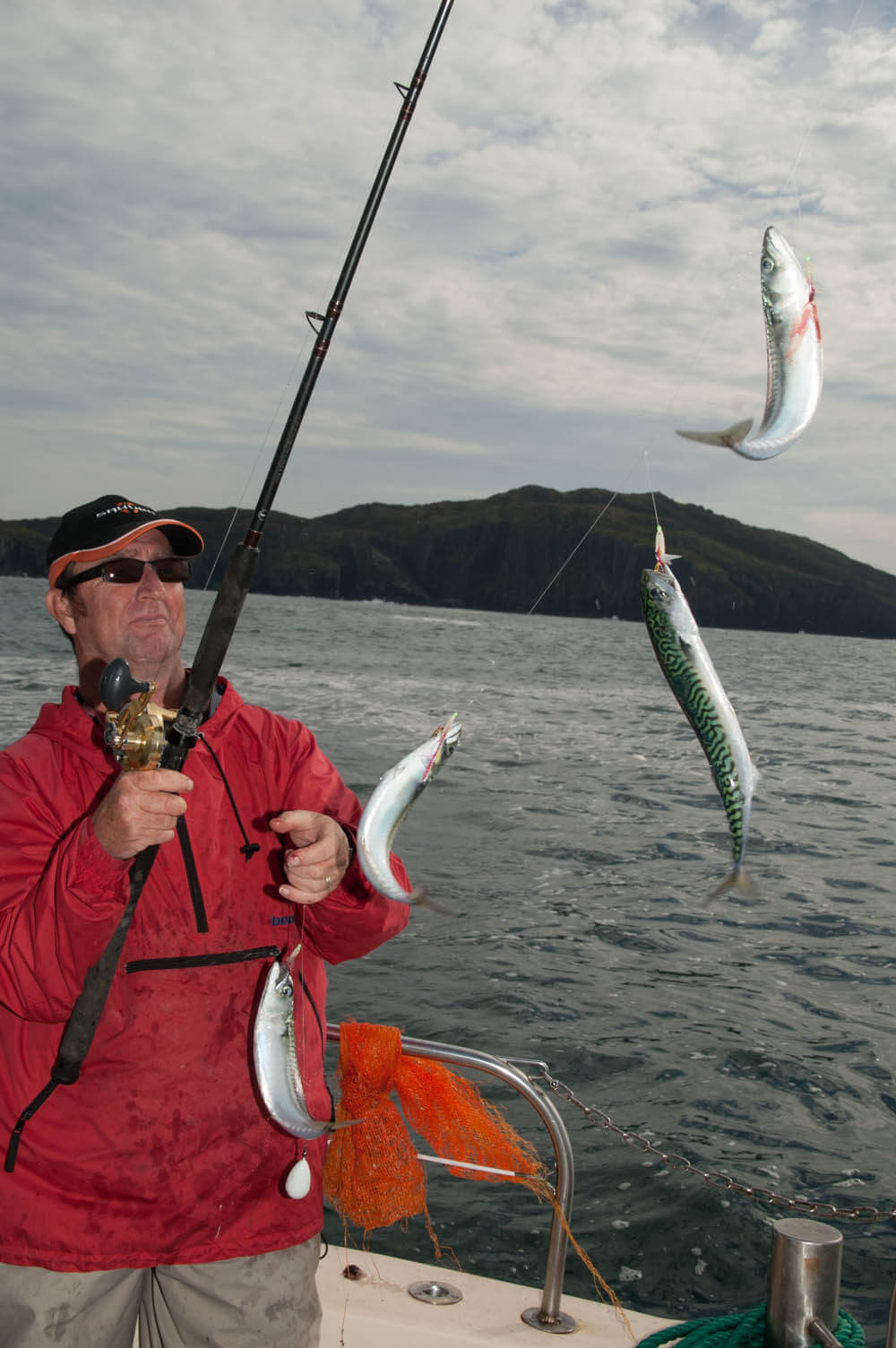
STORAGE
Whilst actually fishing for bait, keep the mackerel in a cool box rather than leaving them exposed to the drying air. This applies to the boat, too. Mackerel left in the bottom of a fish box quickly deteriorate and make inferior baits.
For storing in the freezer for the long term, pack the fish in separately which speeds up the time it takes for the whole body to freeze. If you pack them in multiples of four fish or more, then it can take several hours for the fish to fully freeze in the centre which allows decay to continue.
Frozen or fresh mackerel carried for bait needs to be housed again in a cool box with cool packs added. This keeps the flesh more solid and allows unused baits to be returned home for future use.
PRESENTATION STRIPS
Cut strips of mackerel from the fillet 1.5ins by .5ins for dabs, whiting, dogfish, etc, or longer strips for small rays, big whiting, gurnards and medium sized bottom feeders.
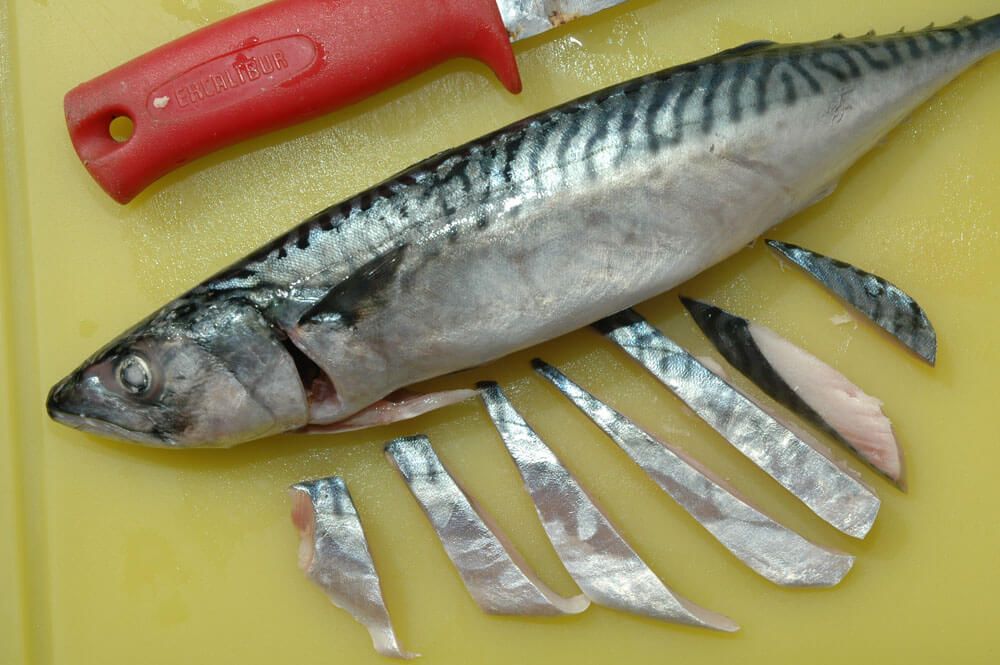
FILLETS
Half a fillet cut lengthways is a good turbot or ray bait fished on the drift, as are full fillets. A whole fillet is also good for bass, huss, rays, conger and even reef pollack. Fillets can also be added to pirks when wreck fishing and take big pollack, ling and cod.
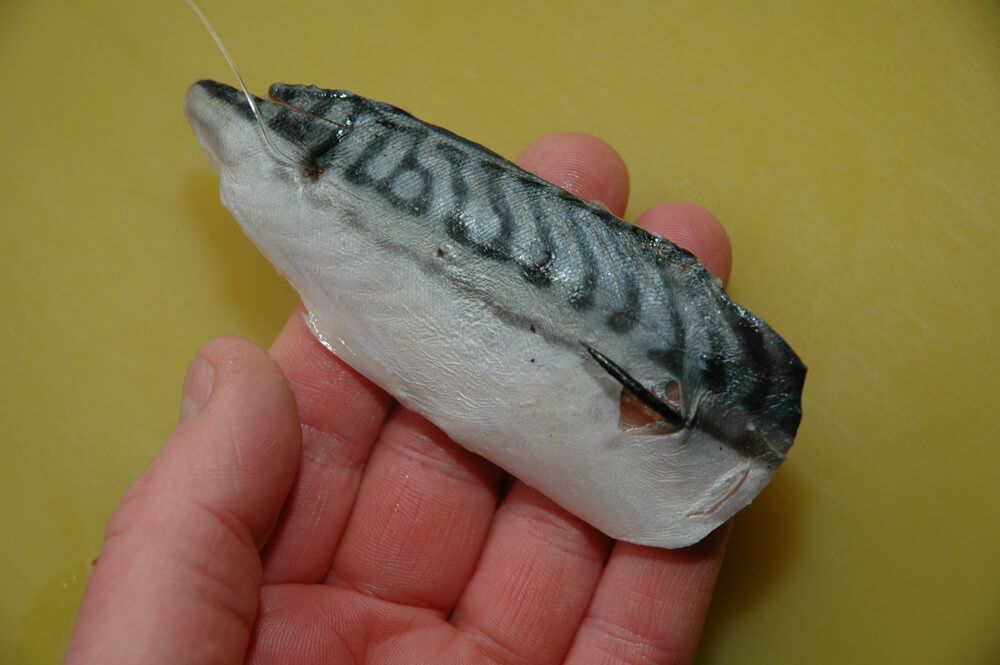
A flapper mackerel is a whole mackerel with the backbone cut out, but the fillets left attached to the head. This is excellent for large ling, conger, huss, tope, and rays.
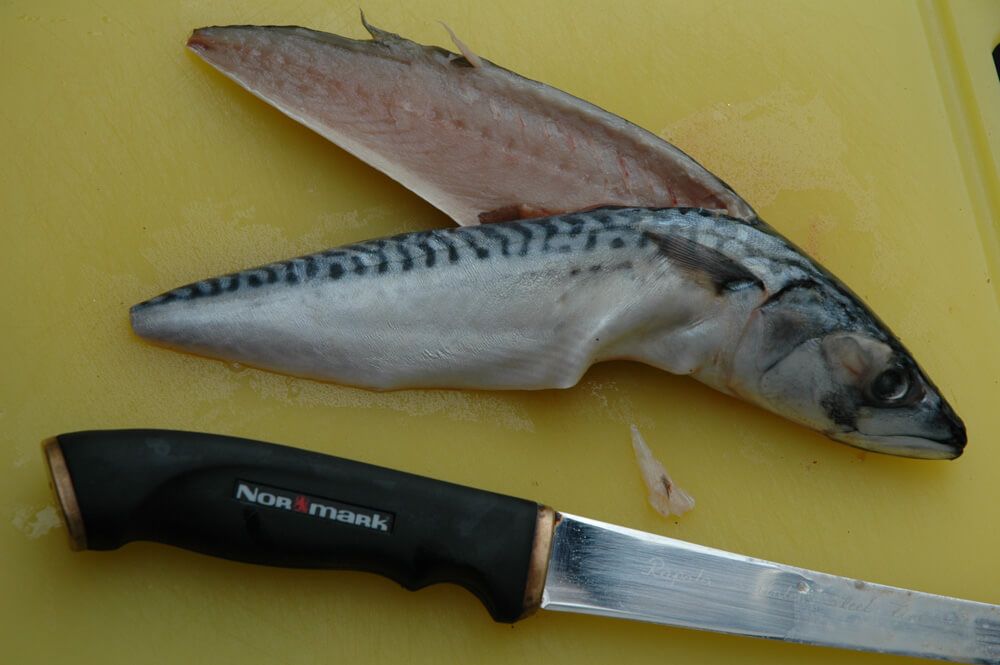
CHUNKS
If you want a smaller amount of bait scent to leak out over a longer period cut the body into chunks straight through one side to the other.
The head with the guts trailing makes a superb bait for huss, big bass, rays and conger. A whole chunk from the centre of the body is a conger, huss, ray, or ling bait. The triangular tail section with the tail fin removed makes a castable streamlined bait for shore tope and conger, or when uptiding for rays.
PRESENTATION TIPS
If you cut a wide strip of mackerel off the fillet about 3ins by 1in, then pass the hook point through one end on the skin side first, then once more at the base of the bait through the flesh side, now bind up the bait sausage shaped so that the flesh is trapped inside the skin, the scent is released slower and this makes a good bait for rock fishing when the bites are few and far between, also for dogfish at night.
When hooking up a whole mackerel and you want to ensure that the hook point remains free of the bait for improved hook ups, push the point of the hook through the top jaw of the mackerel just infront of the eyes and then bring the point round and through above the eyes. This gives a secure hooking point, but leaves the hook point fully exposed for striking as a fish eats the bait.
SEASON
In the south west of England and Wales the first fish show as singles during late April. Mackerel start to shoal together during late May to mid June and move close inshore from June to September before the first of the autumnal gales start to break up the shoals and disperse the fish. Odd fish will still be taken from the shore right through until late November in milder years.
In west Scotland the fish show during May staying until November again, but in the North Sea the mackerel are scarcer and rarely show before July and are gone by early September.
WHERE TO FIND MACKEREL SHORE
Mackerel like tide races, so fish venues like the ends of headlands, breakwaters, jetties, rock edges and piers where the passing tide will hold fish.
Deep water, shingle backed beaches like Chesil Beach in Dorset will hold fish close in from May onwards. Shallower beaches, even clean sand surf beaches will also pull mackerel inshore during the height of summer over high tide in calm conditions.
BOAT
Mackerel in the early season are very scattered, but often appear more numerous around the edges of deep water reefs, or over broken ground.
By mid summer they have shoaled and can be present just about anywhere, but concentrate again around any reefs, over broken ground or flat boulder areas, but again try drifting through tide races off the ends of headlands and the like. Another good place is off estuary mouths on the ebbing tide when the force of the out coming water will pull the mackerel in to feed along the distinctive edge of fresh and saltwater.
Offshore sewer outflows can also be a holding ground for mackerel throughout the season.
WATCH FOR SIGNS
There are signs to look for that help you locate where the mackerel shoals are.
Birds diving into the sea, either close in off the beach or offshore nearly always indicate the presence of mackerel close to the surface.
In the boat, watch for packs of jellyfish suddenly appearing. The jellyfish indicate a slightly warmer water band that will also attract and hold the mackerel.
When mackerel feed they create small air bubbles that break across the surface like that in mineral water. This was how the old commercial fisherman before the time of sounders and engines found the fish. This is easy to see, but few angler know to look.
Spend time feathering near current lines that carry twigs, seaweed and other floating debris. Mackerel like to work these current edges.

TIDES SHORE
From deep water beaches, headlands, breakwaters etc, then neap tides will produce fish, but never in the same quantity as on the bigger spring tides.
From the shallower beaches, then mackerel only move inshore with the very biggest spring tides of the cycle. Fish will rarely, if ever, be present on neap tides.
BOAT
It makes little difference to overall catches, but the mackerel may be more spread out on the spring tides than they are on the neaps, and also much closer to shore.
WEATHER SHORE
The very best conditions are the sultry, thunderous evenings without a breath of wind when the air is oppressive. This sequence sees the mackerel move inshore with the new tide and push baitfish shoals tight in onto the beach line. It also proves good when fishing rock marks.
Once sea conditions start to get choppy, the water starts to colour, and the winds rise the inshore mackerel fishing deteriorates rapidly.
BOAT
During really calm seas the mackerel work very close to the surface. They fall towards the seabed quickly as dusk arrives and cease to feed. Dawn sees them at seabed level, rising higher in the water as the day progresses.
The shoals also stay near the seabed during rough conditions and will leave the shallower areas seeking out more tolerant water with a greater depth.
FISHING METHODS
SHORE
For bait purposes only, feathering is the quickest way to get a box full of baits.
The best feathers are actually lures and not the old mackerel feathers made from cock and hen hackles. Go for Mustad Hokkai's, Shakespeare Flat Jack lures, any feathers with a bright tinsel body such as the Silver Shrimp and also red ribbon lures. Anything with fluorescent colours also catches better than plain feathers.
These are just cast out as far as possible and retrieved erratically until you feel mackerel hook themselves.
More sporting, and often catching enough bait for a single session just as quickly is spinning. Choose any spinner upto about an ounce in silver chrome or gold. A steady retrieve with the spinner works best.

BOAT
The same type of feather/lures used for shore fishing catch just as well offshore.
Instead of using a lead weight as a sinker, use a chromed pirk made from 10mm gas tubing or even a pirk made from 4ins of 1in diameter tubing weighing upto 8ozs. The pirk needs no hook for it's not there to actually catch the fish but the reflections off the pirk help attract the mackerel to the feathers.
Working the feathers is a simple persistent lifting and lowering of the rod tip which imparts some life to the lures and makes them appear like a small group of baitfish.
Don't just let the feathers down to the seabed and then work the rod tip up and down without thinking. The key to consistent mackerel catches, especially early in the season, is to keep trying different depths until the fish are found. Generally speaking, they are close to the seabed early and late in the year, and when seas are calming down after summer storms. In mid summer they can be from seabed to just sub surface, the latter especially during prolonged calm spells.
Another good dodge is to mount a Booby Rattle Bead below the feathers. As the feathers are worked, this obviously rattles and again draws fish in to the lures.

STORAGE
Whilst actually fishing for bait, keep the mackerel in a cool box rather than leaving them exposed to the drying air. This applies to the boat, too. Mackerel left in the bottom of a fish box quickly deteriorate and make inferior baits.
For storing in the freezer for the long term, pack the fish in separately which speeds up the time it takes for the whole body to freeze. If you pack them in multiples of four fish or more, then it can take several hours for the fish to fully freeze in the centre which allows decay to continue.
Frozen or fresh mackerel carried for bait needs to be housed again in a cool box with cool packs added. This keeps the flesh more solid and allows unused baits to be returned home for future use.
PRESENTATION STRIPS
Cut strips of mackerel from the fillet 1.5ins by .5ins for dabs, whiting, dogfish, etc, or longer strips for small rays, big whiting, gurnards and medium sized bottom feeders.

FILLETS
Half a fillet cut lengthways is a good turbot or ray bait fished on the drift, as are full fillets. A whole fillet is also good for bass, huss, rays, conger and even reef pollack. Fillets can also be added to pirks when wreck fishing and take big pollack, ling and cod.

A flapper mackerel is a whole mackerel with the backbone cut out, but the fillets left attached to the head. This is excellent for large ling, conger, huss, tope, and rays.

CHUNKS
If you want a smaller amount of bait scent to leak out over a longer period cut the body into chunks straight through one side to the other.
The head with the guts trailing makes a superb bait for huss, big bass, rays and conger. A whole chunk from the centre of the body is a conger, huss, ray, or ling bait. The triangular tail section with the tail fin removed makes a castable streamlined bait for shore tope and conger, or when uptiding for rays.
PRESENTATION TIPS
If you cut a wide strip of mackerel off the fillet about 3ins by 1in, then pass the hook point through one end on the skin side first, then once more at the base of the bait through the flesh side, now bind up the bait sausage shaped so that the flesh is trapped inside the skin, the scent is released slower and this makes a good bait for rock fishing when the bites are few and far between, also for dogfish at night.
When hooking up a whole mackerel and you want to ensure that the hook point remains free of the bait for improved hook ups, push the point of the hook through the top jaw of the mackerel just infront of the eyes and then bring the point round and through above the eyes. This gives a secure hooking point, but leaves the hook point fully exposed for striking as a fish eats the bait.

